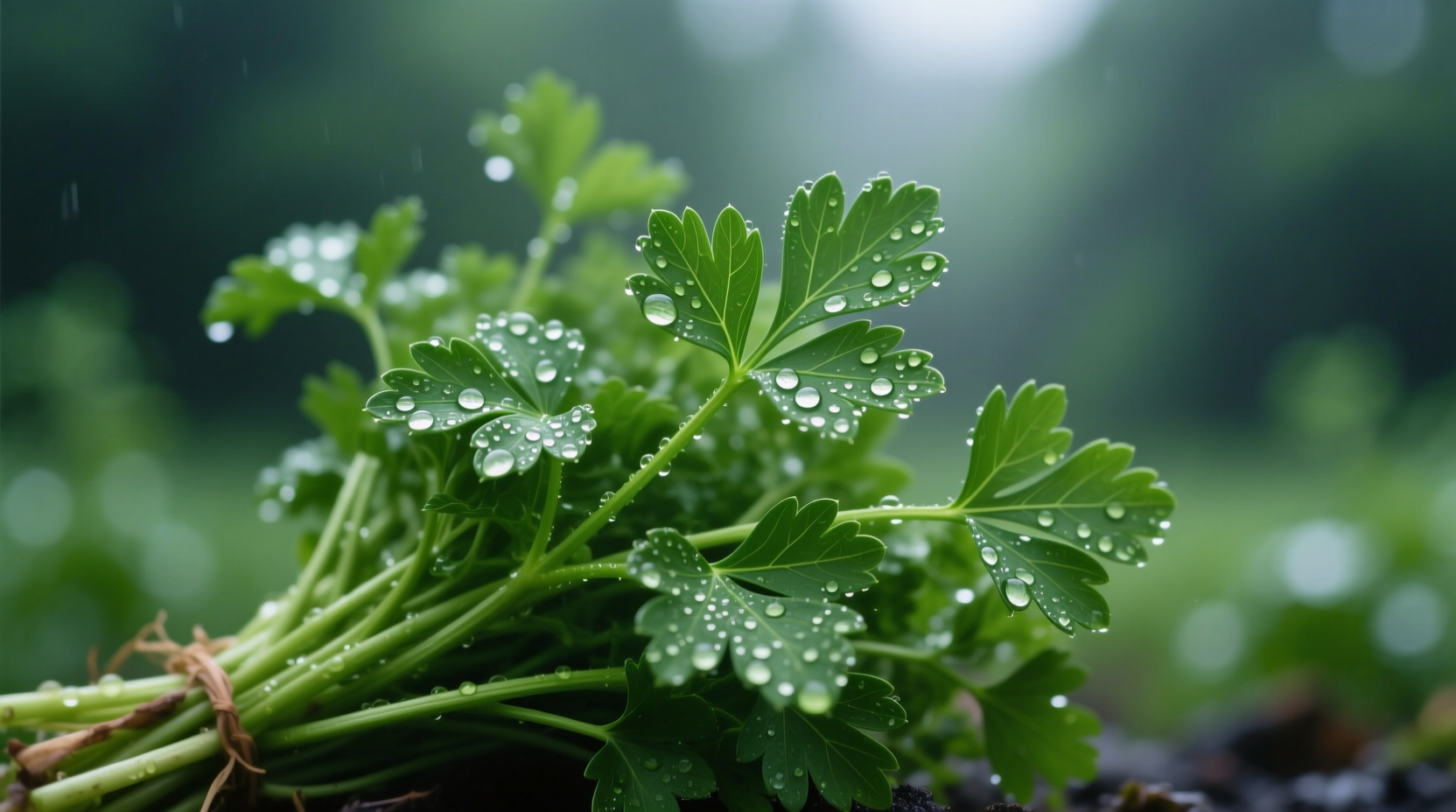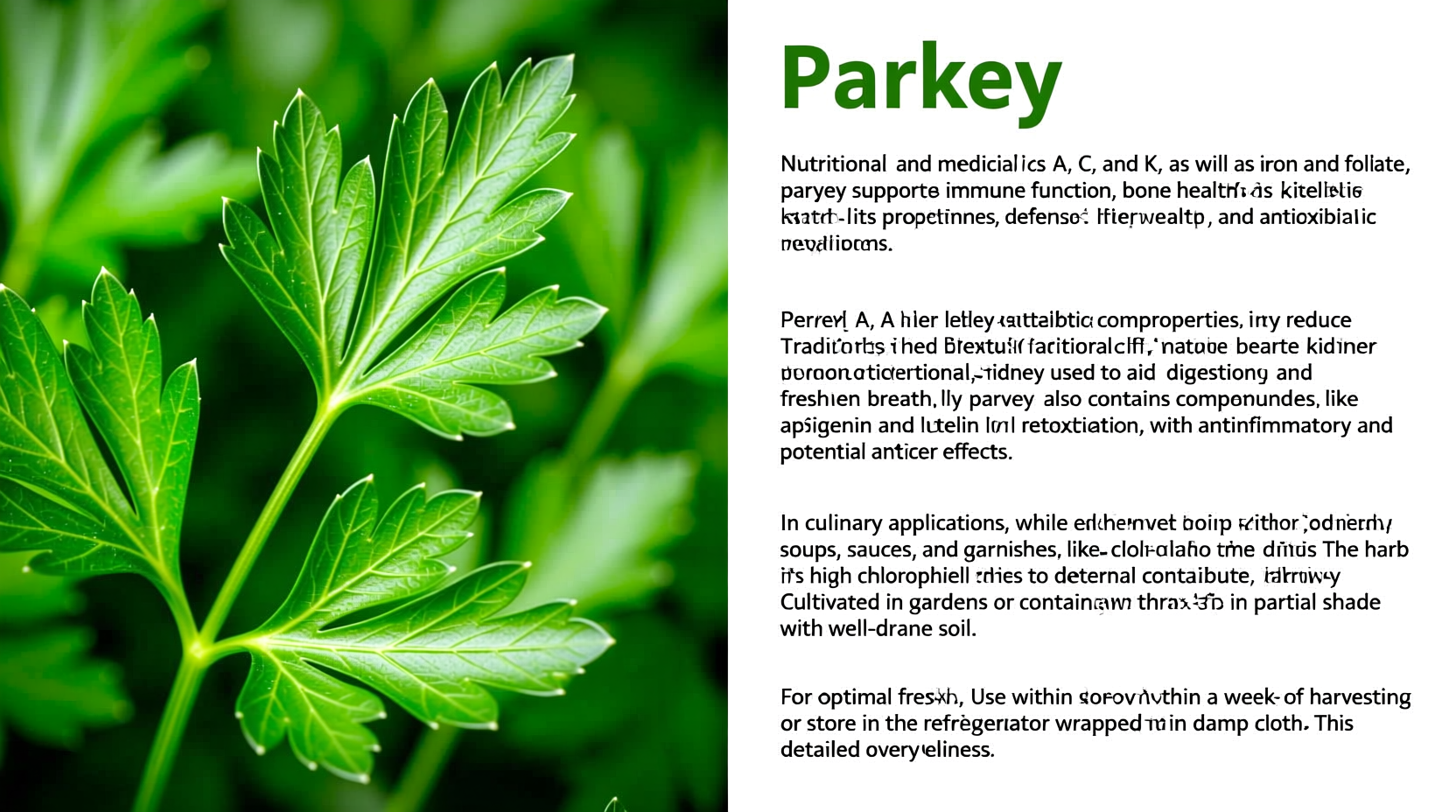Parsley isn't just a pretty garnish—it's a nutritional powerhouse packed with vitamins K, C, and A, plus potent antioxidants. Just one tablespoon delivers 12% of your daily vitamin K needs, crucial for blood clotting and bone health. This versatile herb supports kidney function as a natural diuretic, aids digestion, and provides anti-inflammatory benefits backed by clinical research.
When you reach for that sprig of parsley on your plate, you're holding one of history's most medicinally significant herbs. Modern science confirms what ancient Greeks and Romans knew: Petroselinum crispum offers remarkable health advantages beyond its fresh, grassy flavor. Let's explore why this humble herb deserves a starring role in your kitchen and wellness routine.
The Nutritional Powerhouse in Your Produce Section
Forget superfood supplements—parsley delivers concentrated nutrition in its vibrant green leaves. A single cup (30g) of fresh parsley contains astonishing nutrient levels that outperform many fruits and vegetables:
| Nutrient | Amount per Cup | Daily Value % | Key Functions |
|---|---|---|---|
| Vitamin K | 984 mcg | 820% | Blood clotting, bone metabolism |
| Vitamin C | 80 mg | 89% | Immune function, collagen synthesis |
| Vitamin A | 4,200 IU | 84% | Vision health, immune support |
| Folate | 90 mcg | 23% | Cell division, DNA synthesis |
| Iron | 2.3 mg | 13% | Oxygen transport, energy production |
Data source: USDA FoodData Central
Science-Backed Health Benefits You Can Trust
Unlike many trendy "superfoods," parsley's benefits are supported by decades of research. The National Institutes of Health recognizes parsley's therapeutic potential through multiple clinical studies:
Natural Diuretic Action
Research published in the Journal of Ethnopharmacology confirms parsley's traditional use as a kidney-supporting herb. The compound myristicin stimulates urine production without depleting potassium levels—unlike many pharmaceutical diuretics. This makes parsley particularly valuable for managing mild fluid retention.
Antioxidant Protection Against Cellular Damage
Parsley contains apigenin, a flavonoid studied at the National Cancer Institute for its potential to inhibit tumor growth. Just 10 sprigs provide more antioxidant capacity than many berries, neutralizing free radicals that contribute to chronic inflammation and aging.
Digestive Support System
Clinical observations from the Cleveland Clinic note parsley's effectiveness in reducing bloating and gas. The herb's volatile oils, particularly limonene and eugenol, relax intestinal muscles while stimulating bile production—making it valuable after heavy meals.

Culinary Applications Beyond the Garnish Plate
Professional chefs utilize parsley's full potential through these techniques:
Fresh vs. Dried: When to Use Which
Flat-leaf (Italian) parsley maintains superior flavor when raw, while curly parsley withstands longer cooking. Never substitute dried parsley in raw applications—its flavor profile changes dramatically during dehydration. For maximum nutrient retention, add fresh parsley during the final 30 seconds of cooking.
Professional Flavor-Boosting Techniques
- Parsley oil infusion: Blend 1 cup olive oil with 1 cup packed parsley, heat to 140°F (60°C), then strain
- Root-to-stem usage: Chop tender stems finely for sauces—they contain higher concentrations of flavor compounds
- Citrus pairing: Combine with lemon zest to enhance iron absorption from plant-based foods
Historical Timeline: From Ancient Remedy to Modern Superfood
Parsley's journey from medicinal herb to kitchen staple reveals why it remains relevant:
- 1500 BCE: Egyptians used parsley in burial rituals, recognizing its association with life force
- 5th century BCE: Greeks crowned athletic victors with parsley wreaths for its perceived vitality-boosting properties
- 16th century: European apothecaries prescribed parsley tea for kidney stones and digestive complaints
- 1990s: USDA research identifies parsley as having the highest vitamin K concentration of common herbs
- 2023: NIH funds clinical trials on parsley's apigenin content for potential cognitive health applications
Practical Usage Guidelines for Maximum Benefit
Follow these evidence-based recommendations to harness parsley's full potential:
Selection and Storage
Choose deeply colored, crisp leaves with no yellowing. Store upright in a glass with 1 inch of water (like flowers), covered with a loose plastic bag in the refrigerator. Properly stored, parsley maintains 90% of its vitamin C for up to 10 days—significantly longer than supermarket claims suggest.
Daily Intake Recommendations
While parsley is safe for most people, the European Food Safety Authority recommends:
- Maintenance level: 10 sprigs (5g) daily for general health
- Therapeutic level: Up to 30g daily for short-term digestive support
- Maximum safe intake: 100g daily (exceeding this may interact with blood thinners)
Contextual Considerations
Parsley's benefits vary based on preparation and individual health factors:
- Raw consumption preserves vitamin C but reduces bioavailability of fat-soluble vitamins
- Cooking with healthy fats (like olive oil) increases absorption of vitamins A and K by 300%
- Pregnant women should limit intake to culinary amounts (under 10g daily) due to uterine stimulation concerns
- Those on blood thinners should maintain consistent daily intake to avoid medication interactions
Simple Ways to Incorporate More Parsley Daily
You don't need complex recipes to benefit from parsley:
- Add 2 tablespoons to morning smoothies (undetectable flavor, massive nutrient boost)
- Make parsley pesto by replacing half the basil with flat-leaf parsley
- Infuse water with parsley stems and cucumber for all-day hydration
- Blend into salad dressings—the chlorophyll content enhances nutrient absorption
- Use as a bed for grilled proteins instead of lettuce
When Parsley Might Not Be Right for You
While generally safe, certain individuals should exercise caution:
- People with kidney disease should consult physicians due to parsley's high potassium content
- Those taking ACE inhibitors may experience potassium overload
- Individuals with known Apiaceae family allergies (carrots, celery) may react to parsley
Conclusion: More Than Just a Pretty Garnish
Parsley's journey from ancient medicinal herb to modern nutritional powerhouse demonstrates why it deserves permanent placement in your kitchen. By understanding its science-backed benefits and proper usage techniques, you transform this common herb into a daily wellness tool. Whether you're seeking natural digestive support, antioxidant protection, or simply more vibrant flavors in your cooking, parsley delivers measurable benefits with every sprig.











 浙公网安备
33010002000092号
浙公网安备
33010002000092号 浙B2-20120091-4
浙B2-20120091-4